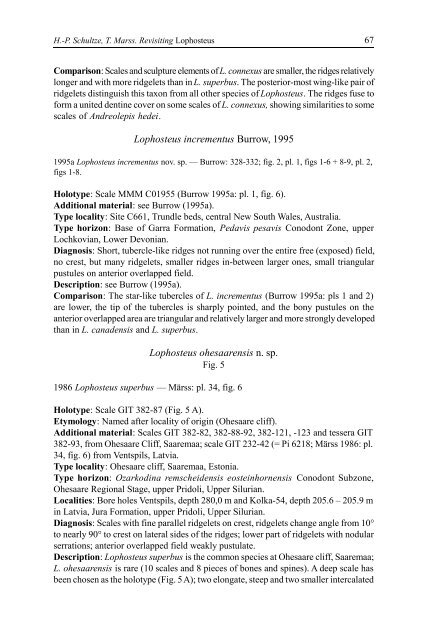Zemes un vides zinātnes Earth and Environment Sciences - Latvijas ...
Zemes un vides zinātnes Earth and Environment Sciences - Latvijas ...
Zemes un vides zinātnes Earth and Environment Sciences - Latvijas ...
Create successful ePaper yourself
Turn your PDF publications into a flip-book with our unique Google optimized e-Paper software.
H.-P. Schultze, T. Marss. Revisiting Lophosteus<br />
67<br />
Comparison: Scales <strong>and</strong> sculpture elements of L. connexus are smaller, the ridges relatively<br />
longer <strong>and</strong> with more ridgelets than in L. superbus. The posterior-most wing-like pair of<br />
ridgelets distinguish this taxon from all other species of Lophosteus. The ridges fuse to<br />
form a <strong>un</strong>ited dentine cover on some scales of L. connexus, showing similarities to some<br />
scales of Andreolepis hedei.<br />
Lophosteus incrementus Burrow, 1995<br />
1995a Lophosteus incrementus nov. sp. — Burrow: 328-332; fig. 2, pl. 1, figs 1-6 + 8-9, pl. 2,<br />
figs 1-8.<br />
Holotype: Scale MMM C01955 (Burrow 1995a: pl. 1, fig. 6).<br />
Additional material: see Burrow (1995a).<br />
Type locality: Site C661, Tr<strong>un</strong>dle beds, central New South Wales, Australia.<br />
Type horizon: Base of Garra Formation, Pedavis pesavis Conodont Zone, upper<br />
Lochkovian, Lower Devonian.<br />
Diagnosis: Short, tubercle-like ridges not r<strong>un</strong>ning over the entire free (exposed) field,<br />
no crest, but many ridgelets, smaller ridges in-between larger ones, small triangular<br />
pustules on anterior overlapped field.<br />
Description: see Burrow (1995a).<br />
Comparison: The star-like tubercles of L. incrementus (Burrow 1995a: pls 1 <strong>and</strong> 2)<br />
are lower, the tip of the tubercles is sharply pointed, <strong>and</strong> the bony pustules on the<br />
anterior overlapped area are triangular <strong>and</strong> relatively larger <strong>and</strong> more strongly developed<br />
than in L. canadensis <strong>and</strong> L. superbus.<br />
Lophosteus ohesaarensis n. sp.<br />
Fig. 5<br />
1986 Lophosteus superbus — Märss: pl. 34, fig. 6<br />
Holotype: Scale GIT 382-87 (Fig. 5 A).<br />
Etymology: Named after locality of origin (Ohesaare cliff).<br />
Additional material: Scales GIT 382-82, 382-88-92, 382-121, -123 <strong>and</strong> tessera GIT<br />
382-93, from Ohesaare Cliff, Saaremaa; scale GIT 232-42 (= Pi 6218; Märss 1986: pl.<br />
34, fig. 6) from Ventspils, Latvia.<br />
Type locality: Ohesaare cliff, Saaremaa, Estonia.<br />
Type horizon: Ozarkodina remscheidensis eosteinhornensis Conodont Subzone,<br />
Ohesaare Regional Stage, upper Pridoli, Upper Silurian.<br />
Localities: Bore holes Ventspils, depth 280,0 m <strong>and</strong> Kolka-54, depth 205.6 – 205.9 m<br />
in Latvia, Jura Formation, upper Pridoli, Upper Silurian.<br />
Diagnosis: Scales with fine parallel ridgelets on crest, ridgelets change angle from 10°<br />
to nearly 90° to crest on lateral sides of the ridges; lower part of ridgelets with nodular<br />
serrations; anterior overlapped field weakly pustulate.<br />
Description: Lophosteus superbus is the common species at Ohesaare cliff, Saaremaa;<br />
L. ohesaarensis is rare (10 scales <strong>and</strong> 8 pieces of bones <strong>and</strong> spines). A deep scale has<br />
been chosen as the holotype (Fig. 5 A); two elongate, steep <strong>and</strong> two smaller intercalated
















